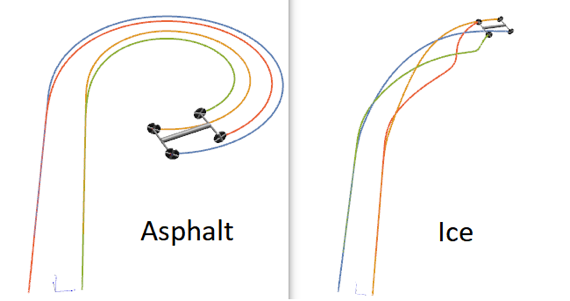Sliding Car
Examining different car wheel setups is crucial to evaluating if a certain wheel is suitable to drive on a certain terrain. The model presented here will examine different wheel types interacting with different ground types.
To run this example, you'll need
The latest versions of System Modeler and Mathematica.
Please make a selection:
Get afree trial Continue
with download
The Model
Modeling interaction between a car wheel and the ground requires using different friction coefficients for different combinations of tires and surfaces. For example, a summer tire on dry asphalt could have a friction coefficient of 0.9, while the same tire on ice would have a friction coefficient of about 0.1. In addition to the friction coefficient, essentially everything else about the tire might also be different; for example, radius, mass and even the friction model could be different. To model this problem efficiently, a model has been set up in a planar environment (based on the TwoTrackWithDifferentialGear model from the PlanarMechanics library) with a replaceable wheel model. By changing this wheel model, all four wheel-to-ground models are replaced instantly, while the rest of the model remains the same. The model examines the car’s behavior when making a sharp turn.

A virtual test rig for the car. All model components are available in the PlanarMechanics library combined with this downloadable example. At the bottom of the image, a drop-down menu is shown that is used to redeclare the wheel model used in the car.
Quickly Change All Tires at Once
Use a drop-down menu of wheel configurations to customize your model.
Simulation Results
To see the difference between two scenarios, you can simulate two different cases and examine the animation (seen in the following video). In both scenarios, the car will accelerate, going straight forward, and then do a sharp turn after 7 seconds. The scenario with summer tires on asphalt can perform this without problems, while the summer tires on ice start slipping almost instantly.
Compare two different scenarios: the left video with a car with summer tires on asphalt, and the right video with a car with summer tires on ice. You can see traces of how the tires move throughout the simulation.

Animation result of the two scenarios. The summer tire on asphalt is shown to the left, and the summer tire on ice is shown to the right. The tires have traces on them to show position over time.
Wolfram System Modeler
Try
Buy
System Modeler is available in English
and Japanese
on Windows, macOS & Linux »
Questions? Comments? Contact a Wolfram expert »